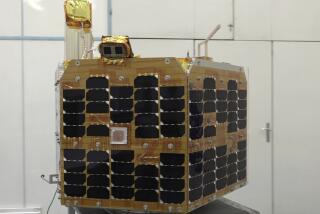Sky Spectacular Package Orbited; Atlantis Scrubbed
- Share via
CAPE CANAVERAL, Fla. — On the fourth try, a newly repaired Atlas rocket blasted off today with a satellite that will splash the sky with colorful cloud displays while illuminating Earth’s usually invisible magnetic field.
The 143-foot unmanned rocket roared into a clear sky on time at 12:21 p.m., PDT from Cape Canaveral Air Force Station. The satellite was expected to separate from the booster 28 minutes later.
It was the fourth attempt by NASA and rocket builder General Dynamics to launch the Atlas, the first commercial version of the rocket ever flown.
Workers on Tuesday replaced a bad power transfer switch in the Atlas rocket. Monday’s scheduled launch was called off after the Atlas failed to transfer power just before liftoff.
Bad weather forced postponement of Sunday’s launch attempt and a helium leak was responsible for Friday’s unsuccessful try.
The rocket carries the $189-million Combined Release and Radiation Effects Satellite, bound for an elliptical orbit 217 miles by 22,236 miles high. The satellite is a joint program of the National Aeronautics and Space Administration and the Defense Department.
The 2-ton satellite contains barium, lithium and other chemicals that will be ejected into space at various altitudes over the next year. The sun’s ultraviolet rays will ionize the chemicals, creating large, glowing clouds that will spread along Earth’s invisible magnetic field lines.
The clouds are expected to resemble the aurora borealis, or the northern lights. The displays will be visible on Earth to the naked eye.
The satellite originally was to have been deployed by astronauts aboard Challenger, but the shuttle’s destruction in a 1986 explosion pushed back all shuttle missions. NASA and the Air Force opted for a quicker ride aboard a commercial Atlas 1 rocket, and the satellite was redesigned to fit inside it.
Also today, NASA said the space shuttle Atlantis faces a trip back to the hangar for repairs, throwing shuttle flight plans into even more disarray, if engineers determine a hydrogen leak that reappeared Wednesday makes it unsafe to fly.
The shuttle’s classified Pentagon flight is on hold, along with Columbia’s astronomy mission, pending analysis of Wednesday’s tests. Columbia also is crippled by a hydrogen leak.
More to Read
Sign up for Essential California
The most important California stories and recommendations in your inbox every morning.
You may occasionally receive promotional content from the Los Angeles Times.













